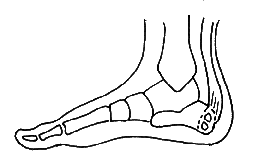|

What is it?
Sever's disease or Calcaneal apophysitis
is a condition that affects children between the ages of 10 and 13
years. It is characterized by pain in one or both heels with
walking. During this phase of life, growth of the bone is taking
place at a faster rate than the tendons. Hence there is a relative
shortening of the heel-cord compared to the leg bones. As a result,
the tension the heel-cord applies to the heel bone at its insertion
is very great. Moreover, the heel cord is attached to a portion of
the calcaneus (heel bone) that is still immature, consisting of a
mixture of bone and growing cartilage, called the calcaneal
apophysis, which is prone to injury. Compounding to this is the fact
that all these changes are happening in a very active child, prone
to overuse. The end result is therefore an overuse syndrome of
injury and inflammation at the heel where the heel cord (Achilles
Tendonitis) inserts into the heel bone (Calcaneal apophysitis).
What are the symptoms?
The typical patient is a child between 10 and 13 years of age,
complaining of pain in one or both heels with running and walking.
The pain is localized to the point of the heel where the tendo-Achilles
inserts into the calcaneus, and is tender to deep pressure at that
site. Walking on his toes relieves the pain.
What does your doctor do about it?
X-rays are normal in Sever's disease, but your doctor will
probably get X-rays to rule out other problems. Treatment consists
of non-steroidal anti-inflammatory medications and use of a heel
lift to relieve tension on the calcaneal apophysis. In more severe
cases, phycical therapy consisting of modalities to relieve the
pain, and stretching exercises may be helpful. In extreme cases,
castings have been used.
What can be expected of the future?
Sever's disease is an overuse syndrome involving an immature part
of the skeleton. Pain goes away when the overuse is over, or when
the growing is done. Hence, the disease is self-limited, in that the
pain goes away eventually when growth in the heel bone is complete
at about age 13. Even if the child is hurting, as long as he can
tolerate it, he may continue to take part in sports. No long term
disability is expected from this problem. |